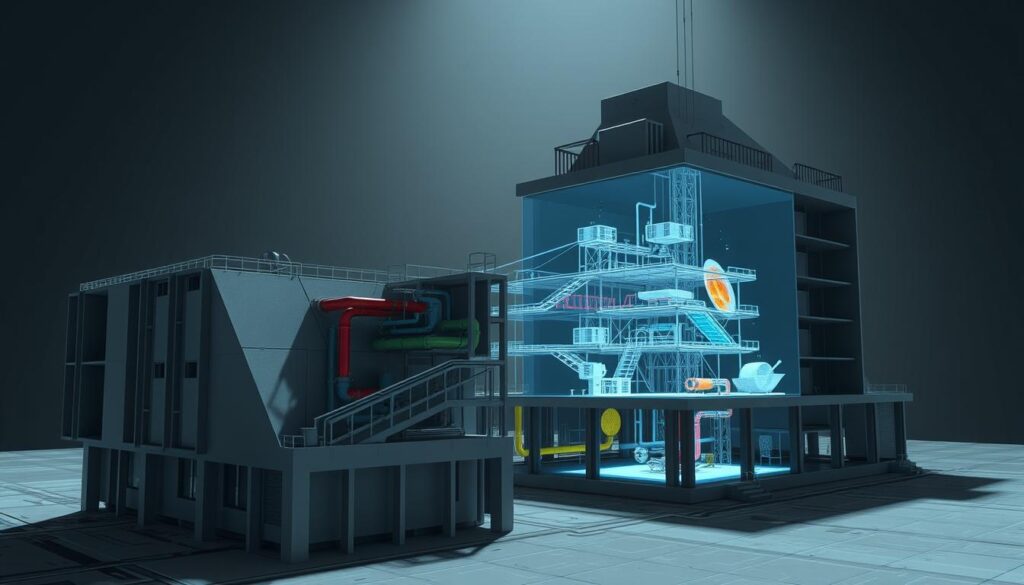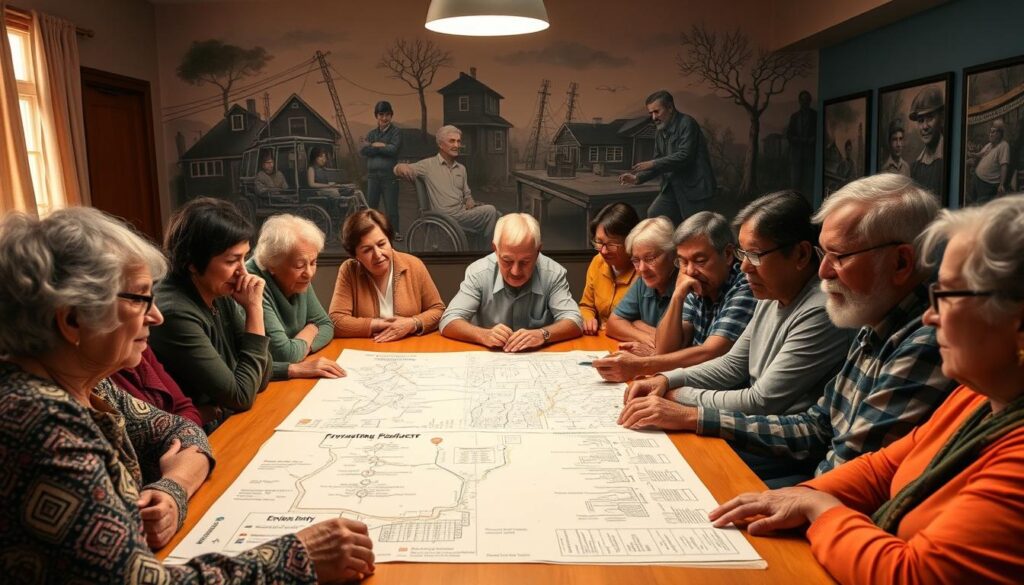Every year, natural disasters cause catastrophic damage to infrastructure, resulting in significant economic losses and loss of life. Disaster-resistant civil engineering plays a crucial role in mitigating these impacts by developing resilient infrastructure that can withstand such disasters.
The importance of disaster-resistant infrastructure cannot be overstated, as it directly affects communities’ ability to recover from disasters. Civil engineers are at the forefront of this challenge, employing innovative design practices to enhance infrastructure resilience.
Key Takeaways
- The role of disaster-resistant civil engineering in mitigating natural disaster impacts.
- Innovative practices in disaster-resistant infrastructure design.
- The importance of resilient infrastructure for community recovery.
- Challenges faced by civil engineers in developing disaster-resistant infrastructure.
- The economic benefits of investing in disaster-resistant civil engineering.
Introduction to Disaster-Resistant Engineering
As the world grapples with the challenges posed by climate change, disaster-resistant engineering has emerged as a vital discipline in civil engineering. The increasing frequency and severity of natural disasters have highlighted the need for infrastructure that can withstand such events, minimizing damage and loss of life.
Importance of Disaster Resilience
Disaster resilience is crucial for communities worldwide, as it enables them to prepare for, respond to, and recover from natural disasters. Resilient design solutions play a key role in this process, ensuring that buildings and infrastructure can resist or absorb the forces generated by disasters such as earthquakes, floods, and storms.
The importance of disaster resilience extends beyond the immediate response to disasters; it also involves long-term recovery and the ability of communities to rebuild and adapt. This requires a comprehensive approach that includes not just the design and construction of resilient infrastructure, but also community engagement, education, and planning.
Overview of Civil Engineering’s Role
Civil engineering plays a pivotal role in disaster-resistant engineering, as it encompasses the design, construction, and maintenance of infrastructure. Civil engineers are responsible for developing resilient design solutions that take into account the potential hazards and risks associated with different regions.
The role of civil engineers extends beyond the technical aspects of design and construction; they must also collaborate with policymakers, community leaders, and other stakeholders to ensure that infrastructure projects meet the needs of the communities they serve.
| Aspect | Description | Importance |
|---|---|---|
| Design | Involves creating structures that can withstand natural disasters | High |
| Construction | Ensures that structures are built according to resilient design specifications | High |
| Maintenance | Ongoing inspections and repairs to maintain infrastructure integrity | Medium |
Aim and Scope of the Article
This article aims to provide a comprehensive overview of disaster-resistant engineering, highlighting its importance, the role of civil engineering, and the innovations in resilient design solutions. The scope includes examining the challenges faced by engineers, the latest advancements in materials and technologies, and the importance of community engagement and policy support.
By exploring these aspects, the article seeks to contribute to a deeper understanding of how disaster-resistant engineering can be advanced to better protect communities and infrastructure from the impacts of natural disasters.
Key Challenges in Disaster-Resistant Design

The quest for disaster-resilient infrastructure is fraught with challenges that engineers must overcome. Designing structures that can withstand natural disasters requires a deep understanding of the various hazards and the ability to implement effective design strategies.
Natural Hazards: Earthquakes, Floods, and Storms
One of the primary challenges in disaster-resistant design is mitigating the impact of natural hazards such as earthquakes, floods, and storms. These events can exert significant forces on structures, leading to potential failures if not properly designed.
Earthquakes, for instance, generate seismic waves that can cause buildings to collapse if they are not designed with seismic resilience in mind. Similarly, floods and storms can lead to water damage and structural failure due to high winds or water pressure.
Economic Constraints and Budget Limitations
Economic constraints are another significant challenge in disaster-resistant design. Implementing resilient design measures often requires substantial investment, which can be a barrier for many communities or organizations with limited budgets.
Engineers must balance the need for resilience with the available budget, making cost-effective design decisions that do not compromise safety. This can involve selecting materials and design techniques that offer the best balance between cost and resilience.
Regulatory and Code Compliance Issues
Regulatory and code compliance issues also pose a challenge in disaster-resistant design. Building codes and regulations vary by jurisdiction and can be complex, making it essential for engineers to stay informed about the relevant requirements.
Compliance with these regulations is crucial not only for legal reasons but also to ensure that structures are designed to withstand local hazards. Engineers must navigate these regulatory landscapes to deliver resilient designs that meet or exceed local building standards.
By understanding and addressing these challenges, engineers can develop innovative solutions to enhance disaster resilience in their designs.
Innovations in Materials for Resilience
Innovative materials are at the forefront of enhancing the resilience of civil engineering projects. The development and application of these materials are crucial in addressing the challenges posed by natural disasters.
Advanced Composite Materials
Advanced composite materials have revolutionized the construction industry by offering enhanced strength, durability, and flexibility. These materials, such as fiber-reinforced polymers (FRP), are being increasingly used in disaster-resistant designs due to their ability to withstand extreme conditions.
Benefits of Advanced Composite Materials:
- High strength-to-weight ratio
- Corrosion resistance
- Flexibility in design
For instance, the use of FRP in bridge construction has shown significant improvements in durability and maintenance costs. According to a study on engineering the future, the application of advanced composites can significantly enhance the lifespan of infrastructure.
Role of Smart Materials in Engineering
Smart materials are another innovation that is transforming the field of civil engineering. These materials can respond to environmental changes, thereby providing real-time monitoring and adaptation capabilities.
Examples of Smart Materials:
| Material | Property | Application |
|---|---|---|
| Shape Memory Alloys (SMA) | Can return to original shape after deformation | Seismic retrofitting |
| Piezoelectric Materials | Generate electricity under mechanical stress | Structural health monitoring |
Sustainable Materials for Eco-Friendly Designs
Sustainability is a critical aspect of modern civil engineering, and the use of sustainable materials is gaining prominence. Materials such as recycled concrete, low-carbon cement, and sustainably sourced timber are being used to reduce the environmental footprint of construction projects.
The integration of these innovative materials not only enhances disaster resilience but also contributes to more sustainable and eco-friendly designs. As the field continues to evolve, the role of materials science in civil engineering will remain pivotal.
Technological Advances in Design Processes

Advances in technology are playing a crucial role in enhancing disaster resilience in civil engineering. The field is leveraging various innovations to improve the design and construction of structures that can withstand natural disasters.
Building Information Modeling (BIM)
BIM is a digital representation of the physical and functional characteristics of a building. It allows for the creation of detailed 3D models that can be used to analyze and simulate various disaster scenarios, thereby enhancing the resilience of structures. By utilizing BIM, engineers can identify potential vulnerabilities and make informed decisions during the design process.
Use of AI and Machine Learning in Design
The integration of AI and Machine Learning in design processes is revolutionizing the field of disaster-resistant engineering. These technologies enable the analysis of vast amounts of data to predict potential disaster impacts and optimize structural designs accordingly. For instance, AI algorithms can be used to analyze data from various sources, including sensors and historical records, to inform design decisions. To learn more about how AI is transforming civil engineering, visit this resource.
Remote Sensing and Data Analytics
Remote sensing technologies, combined with data analytics, are providing valuable insights into disaster risk assessment and mitigation. By analyzing satellite and aerial imagery, engineers can assess damage after a disaster and identify areas of high risk. This information can be used to inform design decisions and develop more effective disaster mitigation strategies.
| Technological Advance | Application in Disaster-Resistant Design | Benefits |
|---|---|---|
| BIM | Detailed 3D modeling for disaster scenario simulation | Enhanced structural resilience, informed design decisions |
| AI and Machine Learning | Data analysis for predictive modeling and design optimization | Improved disaster impact prediction, optimized structural designs |
| Remote Sensing and Data Analytics | Damage assessment and risk identification | Informed design decisions, effective disaster mitigation strategies |
Incorporating Sustainability in Disaster Resilience
As the world grapples with increasing natural disasters, the importance of sustainable engineering approaches comes to the forefront. Sustainability is no longer just an environmental concern but a critical factor in enhancing disaster resilience.
Benefits of Green Building Practices
Green building practices offer numerous benefits that enhance disaster resilience. These practices include using materials and techniques that reduce environmental impact, improve energy efficiency, and promote occupant health. By adopting green building practices, structures can be made more resilient to natural disasters, reducing the risk of damage and loss.
Energy Efficiency: Green buildings are designed to be energy-efficient, which not only reduces operational costs but also minimizes reliance on external power sources during disasters, ensuring that critical systems remain operational.
Lifecycle Assessment in Design Decisions
Lifecycle assessment (LCA) is a method used to evaluate the environmental impacts of a building throughout its entire lifecycle, from construction to decommissioning. Incorporating LCA into design decisions allows engineers to make informed choices that minimize environmental footprint and enhance sustainability.
- Reducing material waste through efficient design
- Selecting materials with lower environmental impact
- Designing for recyclability and reuse
Integrating Renewable Energy Sources
Integrating renewable energy sources into building design is a crucial aspect of sustainable disaster resilience. Renewable energy can provide power during disasters when traditional energy sources may be unavailable, ensuring continuity of operations.
Solar and wind power are among the renewable energy sources that can be integrated into building designs to enhance energy independence and resilience.
Community Engagement in Disaster Planning

Effective disaster planning requires more than just technical expertise; it demands active community engagement. By involving the community in the planning process, we can ensure that disaster resilience measures are tailored to the specific needs of the local population.
Public Awareness and Education
Public awareness and education are critical components of community engagement. Educating the public about disaster risks and the measures in place to mitigate them can significantly reduce the impact of disasters. For instance, a study by the National Science Foundation highlights the importance of public education in enhancing disaster resilience.
Collaborative Approaches to Design
Collaborative design approaches bring together engineers, architects, local authorities, and the community to develop disaster-resistant infrastructure. This collaborative effort ensures that the designs are not only technically sound but also meet the needs and expectations of the community. As seen in projects featured on World Civil Society, such collaborations can lead to innovative and effective solutions.
The Role of Local Knowledge and Input
Local knowledge and input are invaluable in disaster planning. Residents have firsthand experience with the local environment and can provide insights that might not be available through other means. Incorporating local knowledge into the planning process can lead to more effective and sustainable disaster resilience measures.
By fostering a culture of community engagement, we can build more resilient communities that are better equipped to face and recover from disasters. This approach not only enhances the effectiveness of disaster planning but also promotes a sense of ownership and responsibility among community members.
Resilient Infrastructure: Case Studies
Examining case studies of resilient infrastructure reveals innovative approaches to disaster resistance. These examples provide valuable insights into the effectiveness of various strategies in both urban and rural settings.
Successful Examples in Urban Areas
Urban areas face unique challenges due to their high population density and complex infrastructure networks. Successful resilient infrastructure projects in cities often involve a combination of green infrastructure, smart technologies, and community engagement.
For instance, the city of Rotterdam has implemented an innovative flood protection system that includes floating structures and adaptive flood defenses. This approach not only protects the city from flooding but also enhances its environmental and recreational spaces.
“The key to resilient infrastructure is its ability to adapt to changing conditions and withstand extreme events.” –
Rural Community Resilience Projects
Rural communities often have different needs and challenges compared to urban areas. Resilient infrastructure projects in these areas focus on sustainable practices and community involvement.
A notable example is the resilient infrastructure development in rural Alaska, where communities have implemented innovative solutions such as elevated homes and roads to mitigate the effects of permafrost thaw and flooding.
- Community-led planning initiatives
- Sustainable building materials
- Adaptive water management systems
Lessons from Recent Disasters
Recent disasters have provided valuable lessons for improving resilient infrastructure. For example, the aftermath of Hurricane Katrina highlighted the importance of robust levee systems and effective emergency planning.
Similarly, the 2011 Tohoku earthquake and tsunami in Japan demonstrated the effectiveness of seawall defenses and early warning systems in saving lives and reducing damage.
| Disaster | Location | Key Lesson |
|---|---|---|
| Hurricane Katrina | New Orleans, USA | Importance of robust levee systems |
| Tohoku Earthquake and Tsunami | Japan | Effectiveness of seawall defenses and early warning systems |
By studying these case studies and lessons learned, engineers and policymakers can develop more effective strategies for creating resilient infrastructure that protects communities and supports sustainable development.
Policy and Governmental Support

Strong governmental support and well-crafted policies are essential for advancing disaster-resistant civil engineering practices. Effective policies can significantly enhance the resilience of infrastructure, reducing the impact of natural disasters on communities.
Federal and State Programs Overview
The United States has a multifaceted approach to disaster resilience, with various federal and state programs designed to support resilient infrastructure projects. For instance, the Federal Emergency Management Agency (FEMA) provides critical funding and resources for disaster mitigation and response efforts.
Federal Programs: Programs like FEMA’s Hazard Mitigation Assistance (HMA) grant program help states and local communities implement measures to reduce disaster risks.
Financing Mechanisms for Resilient Projects
Financing is a critical component for the success of disaster-resilient projects. Various financing mechanisms are available, including government grants, low-interest loans, and public-private partnerships.
- Government Grants: Grants from federal and state governments can cover a significant portion of project costs.
- Low-Interest Loans: Loans with favorable terms can help finance projects that might otherwise be unaffordable.
- Public-Private Partnerships: Collaborations between public entities and private companies can bring in additional funding and expertise.
Importance of Zoning Regulations and Building Codes
Zoning regulations and building codes play a pivotal role in ensuring that new developments are resilient to disasters. By enforcing strict building codes, communities can reduce the risk of damage from natural hazards.
| Regulation Type | Purpose | Benefits |
|---|---|---|
| Zoning Regulations | Control land use to minimize risk | Reduces exposure to hazards |
| Building Codes | Set standards for construction | Ensures structures can withstand natural disasters |
By combining effective policy support, governmental programs, and robust financing mechanisms, the United States can continue to enhance its disaster resilience. Zoning regulations and building codes are crucial in this effort, ensuring that infrastructure is designed and built to withstand natural disasters.
Role of Research in Advancing Resilience
The role of research in advancing resilience is multifaceted, involving ongoing studies, partnerships, and funding initiatives. Research is crucial for developing innovative solutions to enhance disaster resilience.
Ongoing Studies and Their Implications
Ongoing studies are vital for understanding the complexities of natural disasters and their impact on infrastructure and communities. For instance, research on earthquake-resistant structures has led to the development of advanced materials and design techniques. These studies not only improve our understanding of disaster dynamics but also inform the development of resilient design solutions.
Recent studies have also explored the application of new materials and technologies, such as fiber-reinforced polymers and advanced concrete mixes, to enhance structural resilience. The implications of these studies are significant, as they provide actionable insights for engineers, policymakers, and stakeholders.
Partnerships Between Academia and Industry
Partnerships between academia and industry are essential for translating research findings into practical applications. These collaborations facilitate the exchange of knowledge, resources, and expertise, driving innovation in disaster-resistant design. By working together, researchers and practitioners can develop and implement resilient design solutions that are both effective and feasible.
Examples of successful partnerships include collaborative research projects on advanced materials and structural systems, as well as joint initiatives to develop guidelines and standards for resilient design.
Funding Opportunities for Research Initiatives
Funding is a critical component of research initiatives aimed at advancing disaster resilience. Various funding opportunities are available, including government grants, private foundation support, and collaborative research funding. Securing funding enables researchers to conduct comprehensive studies and develop innovative solutions that can be implemented in real-world contexts.
Researchers and institutions can explore these funding opportunities to support their work in disaster resilience, ensuring that their findings have a meaningful impact on practice and policy.
International Perspectives on Disaster Resistance

As the world grapples with increasingly frequent natural disasters, international perspectives on disaster resistance become crucial. The need for resilient infrastructure is a global concern, with countries around the world facing unique challenges and developing innovative solutions.
Innovations from Around the World
Countries are adopting various innovative engineering practices to enhance disaster resistance. For instance, Japan has been at the forefront of earthquake-resistant design, incorporating advanced materials and technologies into their infrastructure. The United Nations University highlights such global innovations in their report on disaster risk reduction.
In the Netherlands, the focus has been on flood protection, with the development of sophisticated flood defense systems. Similarly, in the United States, cities like Miami are investing heavily in sea-level rise resilience projects, including the elevation of buildings and the enhancement of coastal defenses.
Lessons Learned from Global Disasters
Global disasters have provided valuable lessons in disaster resistance. The 2011 Tohoku earthquake and tsunami in Japan, for example, highlighted the importance of robust design and early warning systems. The tsunami warning systems implemented in the Pacific region have since become a model for other areas.
The impact of Hurricane Katrina on New Orleans underscored the need for resilient infrastructure and effective emergency planning. The city’s subsequent investments in flood protection and levee upgrades demonstrate a proactive approach to mitigating future disasters.
Cross-Cultural Approaches to Resilience
Cross-cultural approaches to disaster resilience involve understanding and integrating local knowledge and practices into disaster risk reduction strategies. In many indigenous communities, traditional building practices have been found to be remarkably resilient to natural hazards.
For example, in some African countries, traditional mud huts have been designed to withstand earthquakes, using techniques passed down through generations. Incorporating such local knowledge into modern disaster-resistant designs can enhance their effectiveness and cultural acceptability.
Future Trends in Disaster-Resistant Engineering
The landscape of disaster-resistant engineering is evolving rapidly, with future trends pointing towards more resilient and adaptable structures. As we move forward, it’s crucial to understand the emerging technologies and strategies that will shape the industry.
Emerging Technologies and Their Impact
One of the significant future trends in disaster-resistant engineering is the integration of emerging technologies. Building Information Modeling (BIM) and Artificial Intelligence (AI) are revolutionizing design processes, enabling engineers to create more resilient structures. According to a report, “The use of BIM has improved the accuracy of designs and reduced the risk of errors during construction.”
“The future of disaster-resistant engineering lies in our ability to harness technology to create adaptable and resilient structures.”
Another critical aspect is the role of sustainable materials in disaster-resistant design. Innovations in materials science are providing engineers with a wider range of options for creating structures that are not only resilient but also environmentally friendly.
The Importance of Adaptability in Design
Adaptability is becoming a cornerstone of disaster-resistant engineering. As previous discussions have highlighted, the ability of a structure to adapt to changing conditions can significantly enhance its resilience.
| Design Aspect | Traditional Approach | Adaptable Design |
|---|---|---|
| Material Selection | Fixed materials | Materials that can adapt to different conditions |
| Structural Flexibility | Rigid structures | Structures designed to flex and absorb stress |
Predicting Future Challenges and Solutions
Predicting future challenges is crucial for developing effective disaster mitigation strategies. By analyzing trends and potential future scenarios, engineers can design structures that are better equipped to handle unforeseen disasters.
- Climate change mitigation strategies
- Advanced materials and technologies
- Community engagement and education
By embracing these future trends and focusing on adaptability and innovation, the field of disaster-resistant engineering can continue to evolve and improve, ultimately saving lives and reducing the economic impact of disasters.
Education and Training for Engineers

Disaster-resistant engineering requires a comprehensive approach to education and training, focusing on both theoretical knowledge and practical skills. As the field continues to evolve, it’s essential that engineers are equipped with the latest techniques and methodologies to design and build resilient infrastructure.
Essential Skills for Disaster-Resistant Design
Engineers involved in disaster-resistant design need a broad range of skills, including knowledge of advanced materials, understanding of complex systems, and the ability to analyze and mitigate risks. Key skills include:
- Understanding of seismic design principles
- Familiarity with wind and flood-resistant construction techniques
- Knowledge of advanced materials and their applications
- Ability to use Building Information Modeling (BIM) and other design software
Incorporating Disaster Management in Curricula
To effectively prepare engineers for the challenges of disaster-resistant design, educational programs must incorporate disaster management into their curricula. This includes courses on risk assessment, emergency planning, and response strategies. For example, programs can include training on innovative civil engineering techniques that enhance building resilience.
| Course Component | Description | Learning Outcomes |
|---|---|---|
| Risk Assessment | Understanding hazards and vulnerabilities | Ability to identify and analyze risks |
| Emergency Planning | Developing response strategies | Knowledge of emergency response protocols |
| Disaster-Resistant Design | Principles and practices of resilient design | Skills in designing resilient infrastructure |
Professional Development Opportunities
Continuing education is crucial for professionals in the field of disaster-resistant engineering. Opportunities for professional development include workshops, conferences, and online courses that focus on the latest advancements and best practices. These opportunities enable engineers to stay current and enhance their skills in disaster-resistant design.
By focusing on education and training, we can ensure that engineers are equipped to design and build infrastructure that can withstand natural disasters, ultimately enhancing community resilience and reducing the risk of damage and loss.
Engaging with Stakeholders in the Process
The success of disaster-resistant initiatives hinges on the ability to engage stakeholders effectively. This involves not just the technical aspects of engineering, but also understanding the social, economic, and environmental contexts in which these projects are implemented.
Multi-disciplinary Collaboration
Effective stakeholder engagement begins with multi-disciplinary collaboration. By bringing together experts from various fields, including engineering, environmental science, sociology, and economics, projects can benefit from a holistic approach to disaster resistance. As noted by experts, “Collaboration is key to developing solutions that are not only technically sound but also socially and environmentally sustainable.”
“The integration of diverse perspectives enhances the resilience and adaptability of disaster-resistant designs.”
Engaging Nonprofits and Community Groups
Nonprofits and community groups play a vital role in nonprofit engagement and community outreach. They provide valuable insights into the needs and concerns of local populations, ensuring that disaster-resistant measures are tailored to the community’s specific requirements. For instance, a project that incorporates local knowledge is more likely to gain community support and be sustainable in the long term.
Building Partnerships with Private Sector
Private sector partnerships are also crucial for advancing disaster-resistant engineering. The private sector can bring innovative technologies and resources to the table, enhancing the effectiveness of disaster-resistant projects. According to recent studies, collaborations between the public and private sectors have led to significant advancements in civil engineering project management, leveraging innovative construction techniques to improve resilience.
By fostering a collaborative environment that includes government agencies, nonprofits, community groups, and the private sector, disaster-resistant engineering can achieve greater impact and sustainability. This multi-faceted approach ensures that projects are not only technically robust but also socially and environmentally responsible.
Strategies for Monitoring and Maintenance

The longevity and safety of civil structures depend heavily on the implementation of comprehensive monitoring and maintenance plans. Ensuring the resilience of these structures against natural disasters requires a proactive approach.
Importance of Regular Assessments
Regular assessments are vital for identifying potential weaknesses in civil structures. By conducting routine inspections, engineers can detect early signs of deterioration, allowing for timely interventions. As emphasized by a study on infrastructure resilience, “Regular maintenance is not just about fixing what’s broken; it’s about preventing breakdowns in the first place.”
This proactive strategy not only enhances the safety of structures but also reduces long-term maintenance costs. It is essential for engineers to stay vigilant and prioritize regular assessments as part of their maintenance protocols.
Use of Technology for Monitoring Structures
The integration of technology in monitoring structures has revolutionized the field of civil engineering. Advanced sensors and monitoring systems enable real-time data collection, providing insights into the structural health of buildings and infrastructure. According to a report, “The use of advanced technologies like IoT sensors can significantly improve the monitoring and maintenance of civil structures.”
Technologies such as Building Information Modeling (BIM) and remote sensing further enhance the ability to monitor and maintain structures effectively. These tools allow for more accurate assessments and informed decision-making.
Developing a Maintenance Culture
Fostering a culture that prioritizes maintenance is crucial for the long-term resilience of civil structures. This involves not only the engineering community but also stakeholders and the general public. Education and awareness campaigns can play a significant role in promoting the importance of maintenance.
As Dr. Maria Rodriguez, a renowned civil engineer, notes, “A maintenance culture is about creating a mindset that values the upkeep of our infrastructure as much as we value its construction.” By instilling this mindset, we can ensure that our structures remain safe and resilient over time.
Conclusion: The Path Forward for Disaster Resistance
As we have explored throughout this article, disaster-resistant civil engineering is crucial for saving lives and reducing the economic impact of natural disasters. The key points discussed highlight the importance of innovative materials, technological advances, and community engagement in enhancing disaster resilience.
Recap of Main Findings
The use of advanced composite materials, smart materials, and sustainable practices has shown significant promise in improving disaster resistance. Additionally, technologies like Building Information Modeling (BIM) and Artificial Intelligence (AI) have revolutionized the design process, enabling more efficient and resilient infrastructure.
Innovation and Future Directions
The role of innovation in future designs cannot be overstated. As new technologies emerge, they will play a critical role in shaping the future of disaster-resistant engineering. Engineers and policymakers must continue to collaborate, investing in research and development to stay ahead of the curve.
Moving Forward
To effectively enhance disaster resistance, a call to action is necessary. Engineers, policymakers, and stakeholders must work together, prioritizing disaster resilience in their projects and policies. By doing so, we can create a safer, more resilient built environment for future generations.
